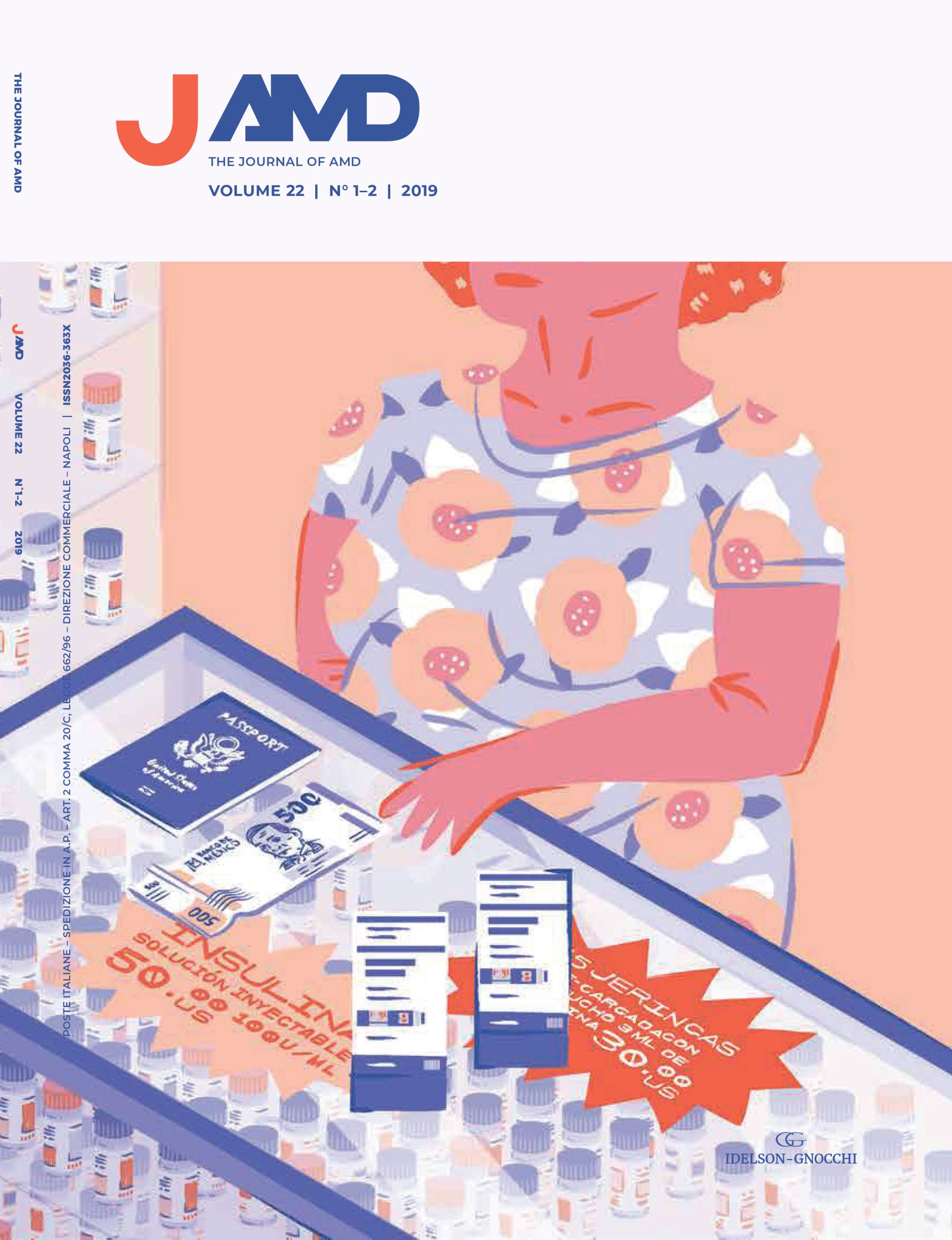Editorial
Stories from the world, #MakeInsulinAffordableAgain
JAMD 2019;22(1-2):4-5
Original articles
CVOTs applicability on SGLT-2i in a real world population of type 2 diabetes patients
JAMD 2019;22(1-2):6-18
OBJECTIVE OF THE STUDY To evaluate the generalizability of the results of recent CVOTs on SGLT2i (EMPA-REG OUTCOMES, CANVAS, DECLARE-TIMI 58 and VERTIS-CV) in patients with T2DM in the real world.
DESIGN AND METHODS Database of AMD Annals 2018 was used in this study, including all patients cared for by 222 diabetes centers during 2016. Starting from the eligibility criteria adopted in the different trials, the analysis aimed to identify the subjects potentially eligible for each trial, compare their characteristics with those of the population recruited in the trials, and evaluate the current use of these drugs among the potentially eligible patients registered in AMD Annals database.
RESULTS The evaluable cases (i.e. presence of information on all eligibility criteria) ranged from 149.064 for the CANVAS to the 342.205 subjects for the EMPAREG-OUTCOME. Overall, the eligible patients in AMD Annals ranged from 40,039 for the EMPAREG OUTCOME study (11.7%) to 144,166 (55.9%) for DECLARE-TIMI 58. The percentage of patients actually treated ranged from 4.4% (6.373) for DECLARE-TIMI 58 to 6.6% (2.917) for CANVAS. As compared to RCTs’ populations, AMD Annals population was older, included a larger proportion of women, showed slightly lower BMI and better metabolic control, and longer diabetes duration. Prevalence of major cardio-cerebrovascular events was lower, while the percentage of subjects with peripheral vasculopathy was higher; the proportion of subjects with reduced glomerular filtrate or albuminuria and diabetic retinopathy was higher.
CONCLUSIONS The generalizability of CVOTs’ results to the real world patients is only partial, because the populations are quite different. A very low clinical use of SGLT-2i is documented. This is at least in part due to the strict AIFA criteria for reimbursement, which reduce the proportion of patients who could benefit from treatment with SGLT2i on major cardiovascular events and mortality; however, an identical advantage of the treatment obtained in RCTs cannot be hypothesized in the AMD Annals population.
KEYWORDS type 2 diabetes; CVOT; real world; generalizability; SGLT2i.
From Ptolemy to Copernicus: a new proposal for the care of diabetes
JAMD 2019;22(1-2):19-27
The therapeutic approach to diabetes has deeply changed in recent years due to the increasing availability of new drugs and the publication of a large number of randomized trials and real life studies focused on cardiovascular and renal safety of these drugs. The therapeutic choice following metformin is particularly complex. The most recent guidelines provide the clinician with indications related to efficacy and safety (effects on weight, hypoglycemic risk, effects on cardiovascular risk factors) directing the therapeutic choice above all in the cardiopathic patient. In this brief review is proposed a different attempt to personalize the therapy after metformin, subordinating the choice to the patient’s pathological history.
KEYWORDS personalized therapy; efficacy; safety; randomized clinical trials; real word data.
The approach of diabetological team to educational therapy of nutrition therapy in different clinical setting: our experiences
JAMD 2019;22(1-2):28-34
The medical nutrition therapy (MNT) is an essential element of therapy in diabetic patients and it should be included in the route of Structured therapeutic Education (ETS) in patients centered care.
Our experience refers to a comparison among three working groups composed of teams experts in diabetes with a diabetologist, a nurse and a dietician who had to experience nutrition therapy in different clinical settings. We chose three scenarios:
- patient with diabetes who is mooving from peadiatric age to adulthood;
- patient with new diagnosed type 2 diabetes and bad glycometabolic control;
- patient with type 1 diabetes, already known, with frequent hypoglycemic crises.
The method used was Metaplan.
Each of the 3 groups followed sligthly different paths depending on the clinical situation that have influenced not only the choices of each operator, but of the whole group.
In accordance with the individual competences, the team has operated synchronously. The premises have been widely shared, while respecting the individual skills, and with differences related to the different organizational situations.
The MNT is a long and articulate path, but in our experience, a personalized initial approach has been recognized by the team as fundamental, both in the initial phase of taking charge, as in the group 1 and in the group 2, and when we have to face important criticalities, as in the group 3.
KEYWORDS diabetologic team; medical nutrition therapy; therapeutic education; paths.
Reviews
Bariatric surgery as a possible choice for therapy and prevention of pelvic floor dysfunctions
JAMD 2019;22(1-2):35-40
In our country, 10% of the population is obese; probably 20% of these subjects are affected by severe obesity (BMI >40) or by obesity complicated by diseases able to reduce life expectancy and to worsen quality of daily living. So these patients will be considered chronically ill. The rapid increase of obesity in the incoming years foresees a percentage of obese people suffering from other chronic diseases much higher than nowadays. Bariatric surgery is an effective remedy to treat those obese who have had no benefit from previous medical and nutritional treatments. Such complex surgery involves doctors of different disciplines, and requires dedicated resources. In particular, for patients (women and men) with pelvic floor diseases, there can be a significant improvement after bariatric surgery in terms of bladder and rectal function, with reduction of problems connected with continence. It is known that urinary and fecal incontinence is more prevalent in obese subjects than in non-obese population. Patients with severe obesity have an increased incidence of pelvic organ prolapsed, stress incontinence, pelvic floor disorders, difficulty with complete bladder emptying, excessive filling incontinence, and bladder irritation symptoms. On the other hand, pathological obesity can be considered an independent risk factor for urinary incontinence and bladder symptoms, but it is really a modifiable factor in case a proper weight loss can be obtained.
KEYWORDS obesity; bariatric surgery; urinary incontinence; fecal incontinence.
Basal insulin treatment optimization in T2DM: GLP-1 Receptor Agonists in loose addition or in fixed dose combination
JAMD 2019;22(1-2):41-53
Administration of basal insulin formulations is often used when oral therapies fail to achieve and/or maintain adequate glucose control in T2DM. However, observational studies documented that a large percentage of basal insulin treated subjects fails to achieve glycemic targets. Among the possible strategies to intensify basal insulin therapy, addition of a GLP-1 RA has several advantages. Indeed GLP-1 RA mechanism of action could be seen as complementary to insulin action. Furthermore, studies have shown that addition of a GLP-1 RA to basal insulin improves HbA1c with a minimal increase in the risk of hypoglycemia and null or modest weight gain. Addition of a GLP-1 RA to basal insulin therapy might be easier if performed by switching from daily basal insulin injections to daily injections of a fixed dose combination of a GLP-1 RA+basal insulin preparation. Two such fixed combinations are presently available, IDegLira (Degludec Insulin + Liraglutide) and IGlarLixi (Insulin Glargine+Lixisenatide). Two studies with IDegLira and one study with IGlarLixi have shown that these combinations are more efficacious and safer than mere up-titration of basal insulin. Use of fixed dose GLP-1 RA+basal insulin combination appears therefore an excellent strategy of basal insulin intensification. No studies are availbe directly comparing efficacy and safety of IGlarLixi and IDegLira. Data obtained in registration trials appear numerically better for IDegLira. Furthermore, as compared to IGlarLixi, IDegLira offers a greater flexibility in time of administration.
KEYWORDS basal insulin; GLP-1 RA; liraglutide; lixisenatide; fixed dose combination.
Punto di vista
Clinical precision
JAMD 2019;22(1-2):54-56
The continuous evolution of diabetology between scientific updates and social changes
JAMD 2019;22(1-2):57-59
Legacy effects in the real world; new evidences
JAMD 2019;22(1-2):60-61
Surveys
Perception of the podologist profession in Italy, by the doctor endocrinologist and metabolic area
JAMD 2019;22(1-2):62-69
AIM The objective of this study is the evaluation of the perception and real knowledge that the doctor working in the diabetological field has of the figure of the Podiatrist.
MATERIALS AND METHODS A questionnaire was distributed with 22 questions at two national events (national diabetology congress). The questions were divided into two sections: the first (1-8) for the classification of the sample of doctors and the second (9-22) to explore the relationship between diabetologist and podiatrist. The answers when not codified have been previously classified into coherent, dubious and non-coherent ones to facilitate data analysis. Only the questionnaires filled in by doctors were analyzed. The sample consists of 81 doctors with a median age of 51.6 ± 9.6 years and with a work experience of 20.7 ± 10.8 years, belonging to the metabolic endocrine area (60%) or general medicine (40%) and with a homogeneous distribution on the Italian territory (31% north, 41% center and 28% south), engaged in hospitals for 74.1% of cases and with a prevalence of women (65%).
RESULTS From the questionnaires filled out by doctors it appears that the patients are not sent by the hospital podiatrist either because they are not present (66%) or because their presence is not known (42%). The same reasons why patients are not sent to podiatrists operating in the area: they are not known (40%) or there are none (40%). In most cases, collaboration with podiatrists is reserved for simple injuries (61%), this is probably related to the reduced knowledge of doctors towards the skills of this professional category. From the data it emerges that the function of the podiatrist is underestimated in 75% of the interviewees while only 62% would like a greater use in prevention and 17% in the active participation of the diabetological team.
CONCLUSIONS The figure of the Podiatrist, in the current state of knowledge has proved to be very little known by the medical class, and involved only for small diseases. Furthermore, it would be desirable to update the professional profile so as to be comparable to that of other European countries.
KEYWORDS podiatrist; diabetologist; diabetic foot; diabetic foot team.
Attività delle sezioni regionali
Congresso Interassociativo AMD-SID Veneto e Trentino Alto Adige «Obiettivo Diabete»
AMD-SID Veneto and Trentino Alto Adige Interassociation Congress «Objective Diabetes»
JAMD 2019;22(1-2):70-5
Le news di AMD
Newsletter Annali AMD n. 25
AMD Annals Newsletter n. 25
JAMD 2019;22(1-2):76-8
Newsletter Rete di Ricerca n. 40
AMD Research Network Newsletter n. 40
JAMD 2019;22(1-2):79-81
Gruppo Medicina di Genere
Gender Medicine Workgroup
JAMD 2019;22(1-2):82-4




